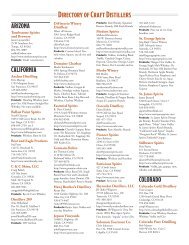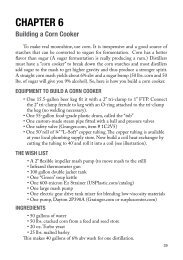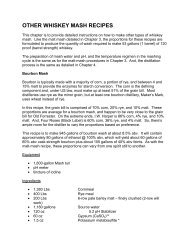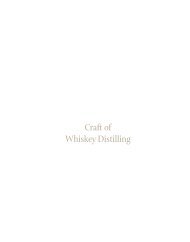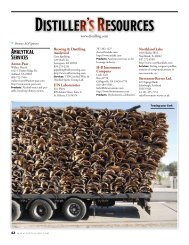502-320-6419 - The American Distilling Institute
502-320-6419 - The American Distilling Institute
502-320-6419 - The American Distilling Institute
Create successful ePaper yourself
Turn your PDF publications into a flip-book with our unique Google optimized e-Paper software.
— C O N T I N U E D<br />
aged, some distillers have been able to experiment<br />
aging their products with new, charred<br />
oak barrels. Others have experimented widely<br />
with wash recipes. <strong>The</strong>y tend to agree that it<br />
is great to have the freedom to release their<br />
products when they see fit, and to have room<br />
for creative expression.<br />
Consumer Education: “not All Rum is bad”<br />
Another significant challenge for <strong>American</strong><br />
craft rum producers is that many consumers<br />
have preconceived notions of what rum<br />
“should be like.” <strong>The</strong>se notions are usually<br />
based on negative experiences with poor quality<br />
distillates, or on the belief that all rum<br />
should fit the flavor profiles already established<br />
by the various styles of Caribbean, Central and<br />
South <strong>American</strong> products. This issue is partly a<br />
product of the historical experience of Prohibition,<br />
as noted before, since cheap rums were<br />
ubiquitous on the black market and the public<br />
perception of rum as a cheap mixer became<br />
ingrained in the <strong>American</strong> drinkers’ collective<br />
consciousness. It is equally due to the fact that<br />
there is a plethora of inexpensive, mass-produced,<br />
big-name brands of rum on the market<br />
today. And finally, from the time of Prohibition<br />
until the mid to late 1990’s, there were no<br />
<strong>American</strong> distillers producing rum. <strong>The</strong> general<br />
public has only had the Islands and South<br />
<strong>American</strong> rums to use as reference guides, and<br />
the cultural associations that attend them.<br />
However, rum producers have differing<br />
views as to just how big of a challenge consumer<br />
education is for them. For Kelly Railean,<br />
proprietor of and distiller at Railean Distillers,<br />
at the Eagle Point Distillery in San Leon,<br />
tX, consumer education is crucial for sales,<br />
and in order to teach people that rum can be<br />
16 w w w . d i s t i l l i n g . c o m<br />
Kelly Railean, proprietor and distiller at Railean Distillers, in San Leon, TX<br />
a great product in its own right. This is not a<br />
big issue on the gulf Coast where she distills,<br />
since the area boasts a large sailing community<br />
with many rum connoisseurs. Rather, getting<br />
the word out past the seaside community is<br />
the real challenge. Railean accomplishes this<br />
through hosting distillery tours, tastings,<br />
speaking at symposiums, and giving lectures.<br />
She explains that when you tell people how<br />
it is made differently from mass-produced<br />
products, first by using quality molasses and<br />
then doing every aspect of production herself<br />
by hand, “People don’t mind paying a couple<br />
dollars more for it. <strong>The</strong>y realize that you can<br />
actually sip a fine aged rum the way you would<br />
a bourbon, whiskey, or a Scotch.”<br />
Andrew Cabot, president of Privateer<br />
International in Ipswich, MA, views consumer<br />
education as “less of a challenge because of<br />
the general ‘Food movement’ in this country.<br />
People are a little more predisposed to listening<br />
these days.” Cabot observes that “there is a<br />
willing and able audience out there.”<br />
More of a challenge for Cabot is the<br />
misinformation about rum that comes from<br />
marketing campaigns, as well as a bias by many<br />
rum experts towards Caribbean and South<br />
<strong>American</strong> rums. “Even experts promote biases,<br />
and they aren’t necessarily aware of them.<br />
Preferences are different from biases.”<br />
Phil Prichard offers some insight as to how<br />
to address the Caribbean and South <strong>American</strong><br />
Ambiguities in the Legal Definition and Interpretation of Rum<br />
ALtHOugH the united States<br />
government Standards of Identity<br />
appear to give a broad interpretation<br />
as to what kind of sugar cane or sugar<br />
cane derivative spirits can be called “rum,”<br />
in practice there has been much ambiguity<br />
and confusion among both distillers and<br />
the Alcohol and tobacco tax and trade<br />
Bureau (ttB) regarding this issue.<br />
For example, a few distillers have sought<br />
to produce a rum-like product whose raw<br />
ingredient is sorghum. Like sugar cane,<br />
sorghum is a species of grass whose juice<br />
can be processed into sweet, fermentable<br />
syrup. So far, the ttB has stated that<br />
spirits made from sorghum cannot be<br />
classified as rum. Because of this, such<br />
products have often fallen under the “spirit<br />
specialty” catch-all designation. However,<br />
Colglazier and Hobson Distillery in Indiana<br />
has recently produced a sweet sorghum<br />
spirit they call “Sorgrhum” and refer to it<br />
as “America’s First Sweet Sorghum Rum”<br />
as well as “Sweet Sorghum Spirit” on their<br />
website. <strong>The</strong>y are currently awaiting label<br />
approval, so it will remain to be seen as to<br />
what class within the Standards of Identity<br />
this spirit will fall.<br />
Another point of ambiguity concerns<br />
rum-like distillates produced from fresh<br />
cane juice. This category ordinarily consists<br />
of cachacas from Brazil and rhum agricoles<br />
from Martinique and the French West<br />
Indies. Cachaca, for instance, has not<br />
been separated into a class of its own in<br />
u.S. Standards of Identity nomenclature.<br />
bill owenS<br />
However, in recognition of the fact that<br />
cachaca is intimately intertwined with<br />
Brazilian culture, the Brazilian government<br />
has taken strong measures to secure use of<br />
the name “cachaca” as a spirit that is internationally<br />
recognized as being exclusively<br />
produced in Brazil. Clearly, Brazil and the<br />
French West Indies are not the only places<br />
that make distillates from fresh fermented<br />
cane juice, but <strong>American</strong> distillers are dissuaded<br />
from using the terms “cachaca” or<br />
“rhum agricole” to describe their similarly<br />
produced spirits.<br />
<strong>The</strong>se are but a few of the legal issues<br />
and questions of nomenclature interpretation<br />
confronting rum distillers in the<br />
united States.<br />
— Nancy Fraley



